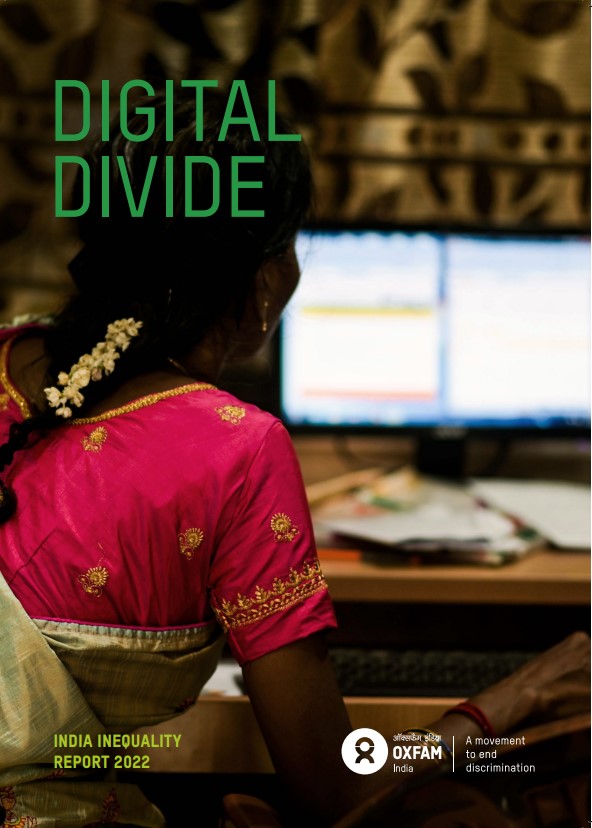India Inequality Report 2022
The report throws light on accessibility and affordability factor in accessing digital services.

The world observed a digital transformation, particularly after the pandemic. Access to the physical world through the virtual world proved beneficial to connect during the pandemic. Oxfam’s India Inequality Report 2022 throws light on accessibility and affordability factor in accessing digital services. These factors leave socio-economic marginalized communities out of the purview of the digital pool and create a Digital Divide.
OECD defines the digital divide as “the gap between individuals, households, businesses and geographic areas at different socio-economic levels with regard to their opportunities to access information and communication technologies (ICTs) and to their use of the internet for a wide variety of activities.”
State of Inequality in Digital Access in India
Technological access is in hands of the privileged group which makes them open to a wide range of opportunities to improve their standard of living. Following are some of the statistics that give a broad reality of the extent of the divide in India.
- Access to a Computer – Poorest 20 percent of households – 2.7%, Richest 20 percent of households – 27.6%. The likelihood of access to a computer is more for the general and OBC groups than for the SC and ST populations.
- Access to Internet – Poorest 20 percent of households – 8.9%, Richest 20 percent of households – 50.5%. On average, the general category is 10% more likely to have a phone than STs from January to April of 2018. This gap dropped to 3% by the end of 2021.
- 40% of mobile subscribers in India do not have smartphones. In India, 70% of the population has poor or no connectivity to digital services.
A Multidimensional Divide
Mere Accessibility is not the factor in an increase in the digital divide. There are other socio-economic factors that put some groups outside of the digital purview. Following are some of the factors that should be taken into consideration to better understand the divide.
Gendered Divide
The use of Internet services between men and women is different. Women are likely to use less likely to use expensive and sophisticated devices. India fares worst among its Asia Pacific peers with the widest gender gap of 40.4%. There is a gap of 30% between men and women having phones. Gender norms are the primary reason for this stark divide where the household decision is in hands of men. Girls were allowed the phone only to attend online classes whereas no such restrictions were imposed on the boys.
Location
31% of India’s rural population uses the internet as against 67% of the urban population. Maharashtra has the highest internet penetration followed by Goa and Kerala. Bihar, Chattisgarh, and Jharkand have the lowest internet penetration. However, the high internet penetration states also have an intra-state divide between rural and urban areas with the latter having the highest internet penetration.
Affordability
The affordability factor plays a role in buying digital services. The average cost of data in India is US $0.68/GB. This will eat a 3% of the share of income of low-income households as against 0.2% of middle-income households. This factor makes low-income households quickly drop from the digital purview. Therefore, the rich are always long-time users of digital services.
Digital Literacy
38% of Indian households are digitally literate. Digital literacy in urban areas is higher (61%) than in rural areas (25%). People who have low educational levels use the internet for entertainment purposes rather than utilitarian purposes.
Digital Divide – Access to Education and Health
The India Inequality Report 2022 delves deeper into the impact of the digital divide on three sectors – Education and Health. The digital divide further marginalized the already marginalized communities.
Education
The infusion of technology during the pandemic and the rise of Edtech products caused the marginalization of low-income students. An average Edtech Product costs INR 20,000 and the per capita income of low-income Indian households stands at INR 25,825 per year.
Health
Access to health digital services proved vital during the pandemic. People who had access to the Internet of Medical Things were more likely to make a quick recovery from COVID-19. The vaccination program through the COWIN app further delayed the vaccination as it targeted people who are digitally literate and have English language skills.
The India Inequality Report 2022 throws light on the impact of the digital divide on financial inclusion and the effects of the privatization of tech space. It gives a detailed approach to the marginalization of various communities due to the digital divide.
You can read the full report here!


